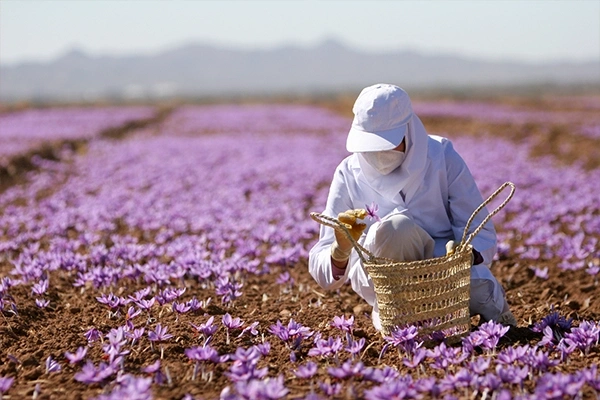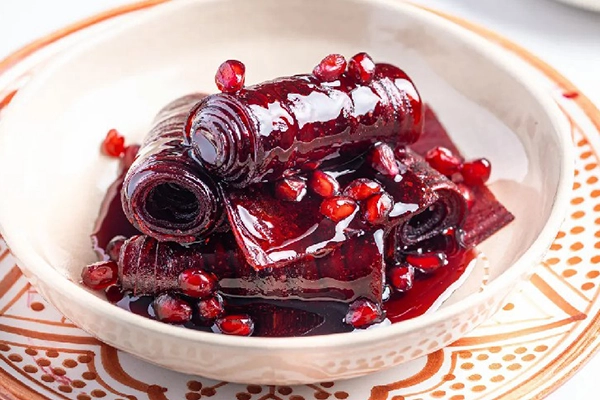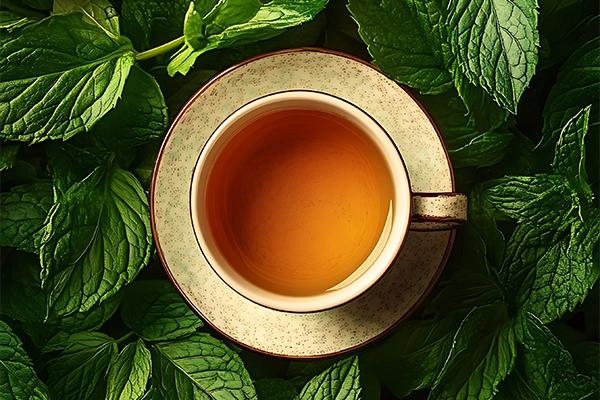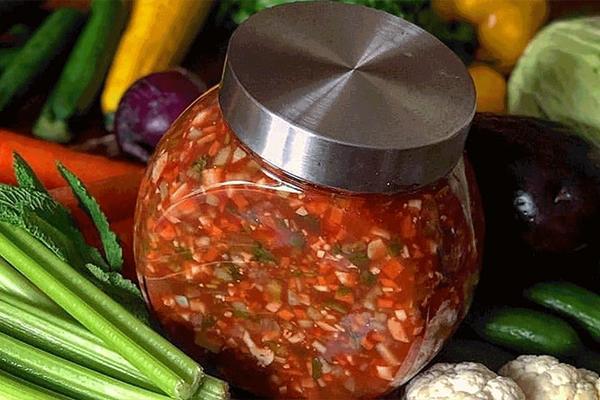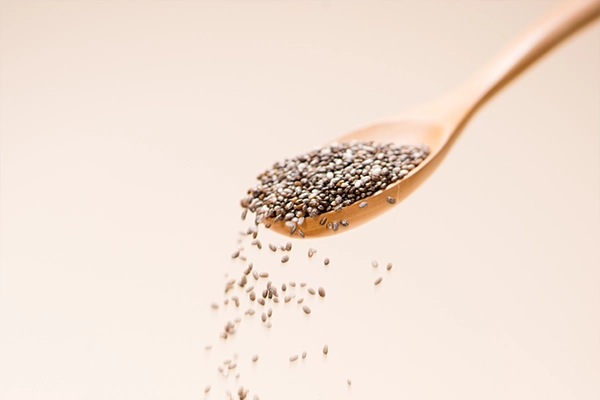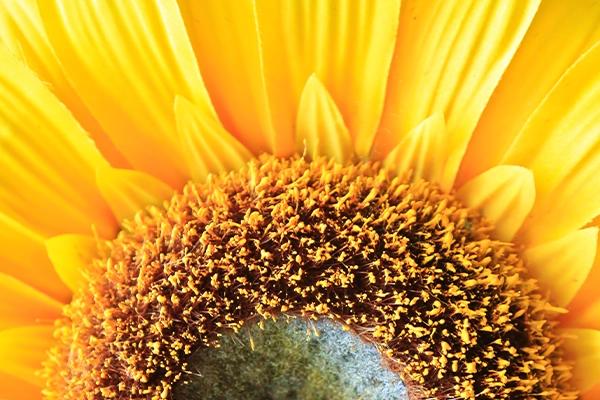Saffron flower, one of the most valuable agricultural products in the world, is obtained from the saffron plant. This plant, with the scientific name Crocus sativus, belongs to the lily family. Saffron is known for its red stigmas, which after harvesting and drying, become the precious spice of saffron. Growing saffron requires special knowledge and skills. This plant grows well in arid and semi-arid regions with mild winters and hot summers. Iran, the largest producer of saffron in the world, has suitable climatic conditions for the cultivation of this valuable product.
Characteristics of Saffron Flower
1. Appearance: The saffron or crocus flower has purple or purple petals with three red stigmas in the center. These stigmas are the valuable part of the plant that are used as spices and natural dyes.
2. Size: Saffron usually has a height between 20 and 30 cm.
3. Leaves: Saffron leaves are narrow and linear and usually appear after flowering.
4. Onion: Saffron grows from a small and round bulb called a corm, which produces new bulbs every year.
5. Flowering: Saffron blooms in autumn, which distinguishes it from other plants.
6. Aroma and taste: Saffron or zaffran flower stigmas have a unique aroma and taste that is a combination of bitterness, sweetness and flower-like aroma.
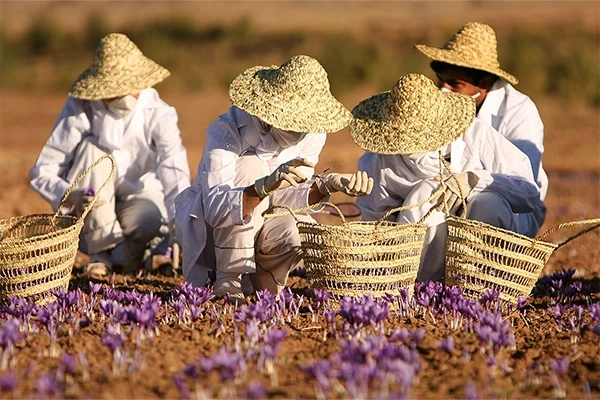
Suitable Environmental Conditions for Saffron Cultivation
1. Climate: The saffron plant is adapted to dry and semi-arid climates. This plant needs mild winters and hot and dry summers. The suitable temperature for the growth of crocus flower is between 10 and 35 degrees Celsius.
2. Soil: Saffron grows best in sandy loam soils with proper drainage. Soil pH should be between 6.5 and 8. The soil should be rich in organic matter and free of stones and lumps.
3. Irrigation: Saffron needs little water. Excessive watering can cause onion rot. Regular watering during the growing season and reducing it during the dormant period of the plant is necessary.
4. Light: Saffron flower needs enough light. This plant grows best in areas that receive at least 6 hours of direct sunlight per day.
5. Altitude: The saffron plant performs best at altitudes between 1300 and 2300 meters above sea level. In these altitudes, suitable temperature and humidity conditions are provided for the growth of saffron. Compliance with these environmental conditions is very important for the success of saffron cultivation.
Steps of Panting and Maintaining Saffron Flower
1. Land preparation:
Plow the ground and add rotted manure to it.
– Smooth the soil.
– Make a suitable plot so that watering can be done easily.
2. Selection and preparation of onions:
– Choose healthy and large onions (weighing about 8 to 10 grams).
Disinfect the onions before planting.
3. Planting time:
– The best time to plant saffron is late summer or early fall.
4. How to plant:
– Place the onions at a depth of 15 to 20 cm in the soil.
– The distance between the rows should be 20 to 25 cm and the distance between the onions should be 10 to 15 cm.
5. Irrigation:
– Irrigate the ground immediately after planting.
– Water regularly during the growing season, but avoid overwatering.
6. Fertilization:
– In early fall and late winter, use nitrogen and phosphorus fertilizers.
Rotten manure can be added to the ground once every two years.
7. Fight against weeds:
– Manual weeding or the use of appropriate herbicides is necessary to control weeds.
8. Harvesting flowers:
– Harvest saffron early in the morning before they fully open.
– Carefully separate the stigmas and dry them in the shade.
Following these steps is necessary for successful saffron cultivation.
Important Tips About Saffron Planting
1. Life cycle: The saffron plant is a perennial plant and can remain in a field for up to 7 years.
2. Flowering: Saffron flowers usually appear in autumn, about 40 to 50 days after planting onions.
3. Propagation: Saffron is propagated by dividing the bulb. Each bulb produces new bulbs over time.
4. Drought resistance: Saffron is resistant to dehydration, but it needs regular watering to produce quality flowers.
5. Pests and Diseases: Care is necessary against pests such as rats and diseases such as onion rot.
Economic benefits of saffron flower cultivation
1. High value: Saffron is one of the most expensive spices in the world and has a high economic value.
2. Low water requirement: compared to other agricultural products, saffron requires less water.
3. Job creation: saffron cultivation and processing can create many job opportunities.
4. Export: Saffron is an important export product and can earn significant foreign exchange.
5. Side products: In addition to stigma, saffron petals are also used in pharmaceutical and cosmetic industries.
6. Sustainability: With proper management, a saffron farm can produce quality crops for years.
Growing saffron at home
saffron plant can also be grown at home. This method is a suitable option for people who are interested in agriculture but do not have enough open space. Growing saffron at home is not only enjoyable, but it can produce a small amount of saffron for personal consumption.
1. Choosing a pot:
- Choose a pot with a depth of at least 15 cm and proper drainage.
- The saffron flower needs enough root space, so the pot should be big enough.
2. Suitable soil:
- Use light and rich soil with good drainage.
- You can prepare a mixture of garden soil, sand and compost.
3. Planting onions:
- Plant healthy saffron bulbs at a depth of 10 to 15 cm.
- The distance between the onions should be about 5 cm.
4. Light:
- Saffron needs enough light. Place the pot in a location that receives at least 6 hours of direct sunlight.
5. Irrigation:
- Water regularly but carefully. Avoid waterlogging of the soil.
- In the sleeping season (summer), reduce watering.
6. Temperature:
- Saffron needs winter cold. In winter, place the pot in a cool place (about 5 degrees Celsius).
7. Nutrition:
- Use diluted liquid fertilizer during the growing season.
8. Withdrawal:
- Harvest saffron early in the morning.
- Carefully separate the red stigmas and dry them in the shade.
important tips:
– be patient. Saffron may not flower in the first year.
– After a few years, remove the bulbs from the soil and divide them so that your saffron remains young and healthy.
Growing saffron at home can be an educational and enjoyable experience. With proper care, you can enjoy the beauty of saffron flower and use its valuable product in cooking.
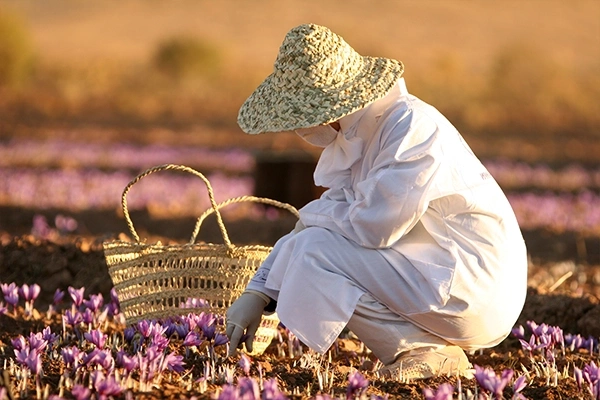
Buy quality saffron from Faraz Hypermarket in Kuwait
After knowing how to grow saffron flower and saffron plant, you may want to buy quality saffron for consumption. If you live in Kuwait or travel to this country, you can get quality saffron from Faraz Hypermarket.
– This store offers quality saffron that is prepared from the best saffron farms.
– The saffron available in this hypermarket is a high-quality saffron product that has been carefully grown and harvested.
– You can find different types of saffron in terms of grading and packaging in this store.
Important tips when buying saffron
1. Pay attention to the color of saffron. High-quality saffron should have a dark red color.
2. Check the smell of saffron. Quality saffron should have a strong and specific aroma.
3. Ask the seller about the origin of saffron and how to produce saffron flowers.
4. Pay attention to the date of production and expiration.
By buying from a reputable hypermarket like Faraz in Kuwait, you can ensure that you are buying quality and original saffron. This saffron is the result of the efforts of farmers who carefully grow saffron and harvest saffron flowers in the best conditions.
Conclusion
In this article, we did a comprehensive review of how to grow saffron flower and agricultural tips related to it. Flower, as the main keyword, is a valuable product obtained from the saffron plant, our secondary keyword. We reviewed suitable environmental conditions, planting and maintenance steps, and additional tips for growing this plant. We also cultivated saffron at home, which is an attractive option for those interested. The economic benefits of saffron cultivation, including high value and low water requirements, have made this product a suitable option for farmers. In the end, we reminded the importance of buying quality saffron and introduced Faraz Hypermarket in Kuwait as a reliable source for buying high-quality saffron. Growing and producing saffron is a delicate and yet profitable art that can produce brilliant results by following the correct principles. to bring Whether on a large scale of agriculture or in a small pot at home, saffron can be a source of beauty and value.
